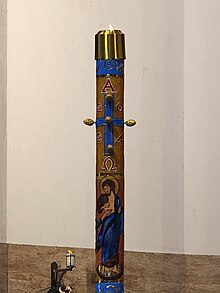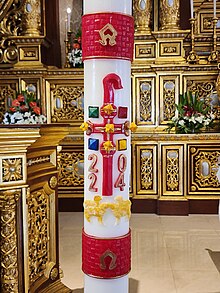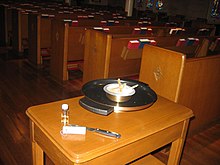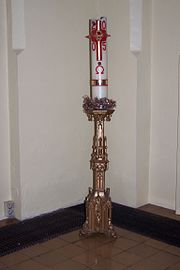Paschal candle

A Paschal candle is a large, white
The equivalent of the Paschal candle in the Eastern Orthodox Church is the Paschal trikirion, which differs in both style and usage.
Etymology
The term Paschal comes from the Latin word Pascha, which came from the Hebrew word Pesach (/ˈpɛsɑːx, ˈpeɪ-/ ; פֶּסַח), meaning Passover, and relates to the Paschal mystery of salvation. It is sometimes referred to as the "Easter candle" or the "Christ candle".
Description

For congregations that use a Paschal candle, it is the largest candle in the worship space. In most cases the candle will display several common symbols:
- The cross, which is the most prominent symbol and most clearly identifies it as the Paschal candle
- The omega, which symbolize that God is the beginning and the end (from the Book of Revelation)
- The year when the particular candle is being used, which represents God amidst the present congregation
- Five grains of five wounds of Jesus: the three nails that pierced his hands and feet, the spear thrust into his side, and the thorns that crowned his head.
In the (medieval) Church, Paschal candles often reached a stupendous size. The Paschal candle of Salisbury Cathedral was said to have been 36 feet (11 metres) tall. At present time, in the United States and Southern Europe (e.g., Italy and France) the candle is approximately 4 inches (10 centimetres) in diameter and 36 to 48 inches (91 to 122 centimetres) tall; in Northern Europe the candle tends to be shorter in height (19 to 24 inches/48 to 61 centimetres) and wider in diameter (3 to 5 inches/7.6 to 12.7 centimetres). The Paschal candle of Manila Cathedral usually reaches 4 or 4.5 inches (10 or 11 centimetres) and stands at 50 inches (130 centimetres) tall.
The Paschal candle, like all liturgical candles, must be made at least from the most part of beeswax (ex cera apum saltem in maxima parte).[1] The Church Fathers saw the bee as a symbol of the Virgin Mary.[2] The beeswax symbolized the pure flesh of Christ, received from his mother.[3]
Usage
Easter Vigil
For churches that celebrate the
On Maundy Thursday of the same week the entire church is darkened by extinguishing all candles and lamps. This represents the darkness of a world without God.

At the opening of the Easter Vigil a fire is lit and blessed. The minister will cuts a cross in the wax with a stylus and trace the symbols on the Paschal candle, saying words similar to: "Christ, yesterday and today, the Beginning and the End, the Alpha and the Omega. All time belongs to him and all the ages; to him be glory and power through every age for ever. Amen." He then inserts five grains of incense (reminiscent of the nails used to fasten Christ on the Cross) on the five points of the cross, saying: "By his holy and glorious wounds, may Christ our Lord guard us and keep us. Amen."
The Paschal candle is the first candle to be lit with a flame from this sacred fire, representing the light of Christ coming into the world. This represents the risen

Typically, the worshiping assembly then processes into the church led by the Paschal candle. The candle is raised three times during the procession, accompanied by the chant "The light of Christ" to which the assembly responds "Thanks be to God".
In some communities, it is common for nearby churches of different Christian denominations (e.g. Catholic, Lutheran, Anglican, Methodist and Presbyterian) to make the new Easter Fire together and then after this, each congregation processes back to their own church with their own Paschal Candle for their Easter Vigil celebration; this is considered to be a fostering of ecumenism.
Following the procession the
Accept this Easter candle,
a flame divided but undimmed,
a pillar of fire that glows to the honor of God.
(For it is fed by the holy melting wax, which the mother bee brought forth
to make this precious candle.)
Let it mingle with the lights of heaven
and continue bravely burning
to dispel the darkness of this night!
May the Morning Star which never sets
find this flame still burning:
Christ, that Morning Star,
who came back from the dead,
and shed his peaceful light on all humanity,
your Son, who lives and reigns for ever and ever.
Amen.
From the New Roman Missal:
On this, your night of grace, O holy Father, accept this candle, a solemn offering, the work of bees and of your servants’ hands, an evening sacrifice of praise, this gift from your most holy Church. But now we know the praises of this pillar, which glowing fire ignites for God’s honor, a fire into many flames divided, yet never dimmed by sharing of its light, for it is fed by melting wax, drawn out by mother bees to build a torch so precious. O truly blessed night, when things of heaven are wed to those of earth, and divine to the human.
Therefore, O Lord, we pray you that this candle, hallowed to the honor of your name, may persevere undimmed, to overcome the darkness of this night. Receive it as a pleasing fragrance, and let it mingle with the lights of heaven. May this flame be found still burning by the Morning Star: the one Morning Star who never sets, Christ your Son, who, coming back from death’s domain, has shed his peaceful light on humanity, and lives and reigns for ever and ever.
R. Amen.
In some traditions, the base of the candle may be ritually immersed in the baptismal font before proceeding with the remainder of the service.
This candle is traditionally the one from which all other lights are taken for the Easter service.
Other times of the year

The candle remains lit at all worship services throughout
The Paschal candle is also lit during baptisms to signify the Holy Spirit and fire that John the Baptist promised to those who were baptised in Christ. During the baptismal rite in many traditions, a small lit candle will be given to the newly baptised by a member of the community, with words similar to, "Let your light so shine before others, that they might see your good works and glorify your Father in heaven." (Matthew 5:16)
In the Mass of Paul VI, the Paschal candle is lit and placed near the casket or urn during the funeral services such as the Mass of Repose and the Mass of Requiem. This is to signify the hope of the resurrection into which Christians are baptised.
Eastern usage
In the
References
- ^ Schulte, Augustin Joseph. Altar Candles, in The Catholic Encyclopedia. Vol. 1. New York: Robert Appleton Company, 1907
- ^ https://www.mk-online.de/meldung/die-bedeutung-von-licht-und-kerzen-in-der-katholischen-kirche/
- ^ Schulte, Augustin Joseph. Altar Candles, in The Catholic Encyclopedia. Vol. 1. New York: Robert Appleton Company, 1907.
- ISBN 9780806651156.
Many Christians are already familiar with the ancient, and now recently restored, liturgies of the Three Days: Maundy Thursday, Good Friday, and the great Easter Vigil service of light, readings, baptism, and communion. The worship resources published by the Evangelical Lutheran Church in America, the Episcopal Church, the United Methodist Church, the Presbyterian Church U.S.A. and the Catholic Church include nearly identical versions of these liturgies.
- ^ "CATHOLIC ENCYCLOPEDIA: Paschal Candle".
External links
- The Candle Carving Site
- Herbermann, Charles, ed. (1913). . Catholic Encyclopedia. New York: Robert Appleton Company.
